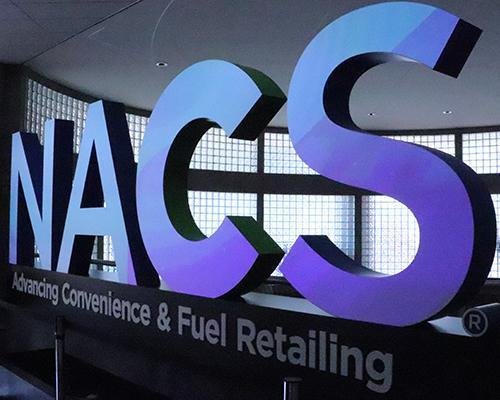
The resiliency of the U.S. convenience retailing industry was amplified in 2021, and the year’s total in-store sales increased to a record $277.9 billion, according to newly released NACS State of the Industry data. The in-store increase in sales came despite a 1.5% decline in the number of convenience stores, which totalled 148,026 stores at the start of 2022.
Factoring in fuels sales of $427.8 billion, total convenience store sales reached $705.7 billion in 2021, meaning that overall sales were 3.1% of the total U.S. GDP of $23.0 trillion in 2021.
The average in-store basket size increased 6.3% in 2021 to $7.59 and has grown 22.4% over the past two years, making up for a 6.9% decrease in in-store transactions since 2019.
Fuel Sales Close In on 2019 Levels
Convenience stores sell approximately 80% of the motor fuels purchased in the United States and saw a return to the pumps as more consumers and commuters hit the road again in 2021, although below pre-pandemic levels in 2019. Total fuel gallons sold increased 4.4% in 2021 but are still 7.2% below the level they were in 2019. Overall, 79% of all U.S. convenience stores (116,641 stores total) sell fuel.
Total convenience store fuel sales increased 46.2% in 2021, reflecting both higher demand and higher gas prices, which averaged $3.02 a gallon in 2021, considerably higher than the average of $2.17 a gallon in 2020.
NACS announced the industry’s operational and performance metrics during the 2022 NACS State of the Industry Summit, the first in-person SOI Summit since 2019. Metrics looked at performance compared to the previous year and to 2019, which allowed comparisons to sales and trends before the pandemic.
“The sales and performance metrics show that our industry is resilient. Our rapid adjustments to product assortment and the embrace of last-mile solutions allowed our industry to hold its own over the past few years, but to grow, especially market basket, is simply remarkable. While there are numerous headwinds facing retail in 2022, I am very optimistic about our channel’s future,” said Charlie McIlvaine, chairman and CEO of Canonsburg, Pa.-based Coen Markets and a member of the NACS board of directors.
Foodservice Bounces Back
Foodservice sales reflected the trend of convenience stores selling more restaurant-quality food. Prepared food, commissary, hot dispensed beverages, cold dispensed beverages and frozen dispensed beverages, saw sales grow 24.1% in 2021 and are 10.6% higher than 2019 levels.
Overall, foodservice accounted for 22.5% of in-store sales in 2021 — significantly higher than the 16.8% reported a decade ago. Foodservice now accounts for 35.5% of in-store gross profits, compared to 29.2% in 2011.
After declining 8.5% in 2020, sales of prepared food — the largest foodservice segment at 66.7% of foodservice sales dollars — surged 25.9% in 2021 and were 15.2% higher than in 2019. Meanwhile, hot dispensed beverages (coffee, tea, hot chocolate) have not recovered to pre-pandemic levels but continue to represent the second-largest segment of foodservice sales at (13.2%), followed by cold dispensed beverages (7.8%), commissary (6.6%) and frozen dispensed beverages (5.8%).
A robust foodservice offer was the greatest predictor of in-store profit; stores in the top decile for in-store store operating profit have foodservice gross profits that were seven times those in the bottom decile.
Economic Engines in Communities
The convenience store industry provided 2.38 million jobs across the United States in 2021. Average wages increased 10.5% for full-time and 12.3% for part-time employees to $13.14 per hour and $12.45 per hour, respectively.
Overall, the industry paid or collected $159 billion in taxes, or 23% of all sales dollars at convenience stores in 2021. On a per-store basis, taxes collected averaged $1.1 million.
Labour Market Headwind
While sales and other financial metrics related to performance were positive, there are concerns related to labour and expenses. Total turnover for retail overall has increased, and it also increased in the convenience channel; turnover in 2021 was 150% — the highest it has been since 2012, according to the NACS State of the Industry Compensation Report of 2021 Data. The full-time employee turnover rate was 119%, and the part-time employee turnover rate was 182%.
Direct store operating expenses increased 14.3% in 2021 versus 2020, and the largest contributor to DSOE was wages and benefits ($71.7 billion), which was up 10.7% compared to 2020 ($64.8 billion) and up 17.1% compared to 2019 ($60.9 billion). Card fees, meanwhile, were up 25.6% in 2021 ($13.5 billion) versus 2020 ($10.7 billion).
Exclusive industry data, analysis and benchmarking by region and profitability cuts will be available in the NACS State of the Industry Report of 2021 Data. Published annually since 1972, the NACS State of the Industry Report is the convenience and fuel retailing industry’s premier benchmarking tool and the most comprehensive collection of data and trends.
A global trade association dedicated to advancing convenience and fuel retailing, NACS advances the role of convenience stores as positive economic, social and philanthropic contributors to the communities they serve and is a trusted adviser to retailer and supplier members from more than 50 countries.
The U.S. convenience store industry, with more than 148,000 stores nationwide selling fuel, food and merchandise, conducts 160 million transactions daily and had sales of $705.7 billion in 2021.